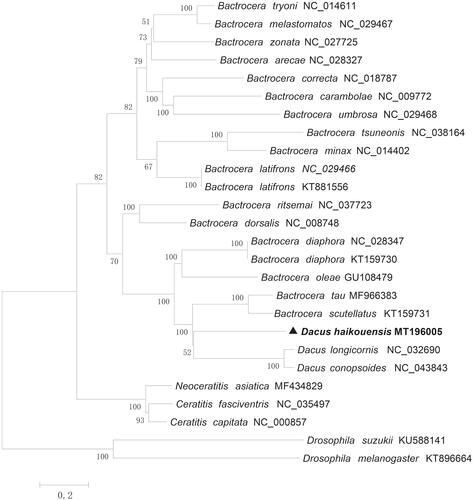Abstract
The complete mitochondrial genome (mitogenome) of Dacus haikouensis Wang and Cheng 2002 (Diptera: Tephritidae: Dacinae) was sequenced and annotated. The mitochondrial genome is 15,291 bp (GenBank No. MZ087939), containing 73.0% AT, which is the classical structure for insect mitogenome. Additionally, the phylogenetic tree confirmed that Dacus haikouedsis clustered with Dacus longicornis and Dacus conopsoides. The current study would enrich the mitogenomes of the fruit flies.
The genus Dacus Fabricius belongs to the tribe Dacini of subfamily Dacinae (Diptera: Tephritidae). Most of these species were found in the Afrotropical region and only a few in the Asian and Pacific Regions. The larvae are known to develop into fruits and flowers of Cucurbitaceae or pods of Asclepiadaceae, and the male adults are usually attracted to Cue lure (Wang and Chen Citation2002). Presently, the identification of Dacus haikouensis is mainly based on morphology, and no mitogenome data was available. Here, we first sequenced and determined the complete mitochondrial genome (mitogenome) using next-generation sequencing method, which might facilitate future studies on population genetics and evolution of the subfamily Dacinae.
The article follows the ARRIVE guidelines (https://arriveguidelines.org/). The genome DNA was extracted from male adult of D. haikouensis, which was collected in Yunlong town, Haikou city, Hainan province, China (E 110°47′97″, N 19°87′75″), in July 2019, and the voucher specimen’s genome DNA labeled GCZX-135 (Yanling Ren and [email protected]) was deposited in the Research Center for Guizhou Characteristic Fruits and its Products of Mountainous Regions, Guizhou Light Industry Technical College. These sequences were assembled using Geneious Primer (Kearse et al. Citation2012), version 10.2.3. Additionally, all tRNAs were found by MITOS server (Bernt et al. Citation2013) and tRNA scan-SE server (Lowe and Chan Citation2016) for annotation. The neighbor-joining (NJ) tree was constructed to investigate the molecular taxonomic position of D. haikouensis basing on nucleotide sequences of 13 protein-coding genes and two rRNA genes using MEGA 6.0 (Tamura et al. Citation2013) from alignments created by the MAFFT (Katoh and Standley Citation2013).
All genes have similar locations and strands with that of other published Tephritidae species. The complete mitogenome of D. haikouensis is 15,291 bp (GenBank No. MZ087939), containing 22 transfer RNA genes (tRNAs, 1,470 bp), 13 protein-coding genes (PCGs, 11,176 bp), two ribosomal RNA genes (rRNAs, 2087 bp), and one non-coding region (Control region, 390 bp). The whole genome contained 39.5% A, 17.2% C, 9.8% G, and 33.5%T, showing an obvious A + T bias (73.0%). The AT-skew (0.0822) for the whole mitogenome is slightly positive, but negative for GC-skew (−0.2741). Most PCGs were started with ATD (ATA/ATG/ATT) as a start codon excepting that ND5 and ND1, which started with GTC and TTC, respectively. The typical stop codon TAA was adopted by nine PCGs (ND2, COX1, COX2, ATP8, ATP6, COX3, ND4, ND4L, ND6) and TAG was adopted by three PCGs (ND3, CYTB, ND1), excepting that only ND5 terminates with a single T residue.
The phylogenetic relationships of D. haikouensis were reconstructed using the neighbor-joining (NJ) method with 1000 bootstrap replicates basing on concatenated nucleotides of 13 PCGs and two rRNAs with 13,484 bp, Dosophila suzukii and Drosophila melanogaster were used as outgroup (). The phylogenetic tree confirmed that Da. haikouensis clustered with Da. longicornis and Da. conopsoides. This implied Da. haikouensis, Da. longicornis and Da. conopsoides have a closer relationship. Presently, the studies recording Da. haikouedsis were limited, and we believe that the current data could be useful for further study.
Ethical approval
Experiments were performed in accordance with the recommendations of the Ethics Committee of Guizhou Mountain Characteristic Fruit and Its Products Research Center, Guizhou Light Industry Technical College. These policies were enacted according to the Chinese Association for the Laboratory Animal Sciences and the Institutional Animal Care and Use Committee (IACUC) protocols.
Disclosure statement
No potential conflict of interest was reported by the author(s).
Data availability statement
The data that support the findings of this study are openly available in Genbank of NCBI at https://www.ncbi.nlm.nih.gov/, reference number MZ087939. The associated BioProject, SRA, and Bio-Sample numbers are PRJNA775834, SRR16633019, and SAMN22630036, respectively.
Additional information
Funding
References
- Bernt M, Donath A, Jühling F, Externbrink F, Florentz C, Fritzsch G, Pütz J, Middendorf M, Stadler PF. 2013. MITOS: improved de novo metazoan mitochondrial genome annotation. Mol Phylogenet Evol. 69(2):313–319.
- Katoh K, Standley DM. 2013. MAFFT multiple sequence alignment software version 7: improvements in performance and usability. Mol Biol Evol. 30(4):772–780.
- Kearse M, Moir R, Wilson A, Stones-Havas S, Cheung M, Sturrock S, Buxton S, Cooper A, Markowitz S, Duran C, et al. 2012. Geneious Basic: an integrated and extendable desktop software platform for the organization and analysis of sequence data. Bioinformatics. 28(12):1647–1649.
- Lowe TM, Chan PP. 2016. tRNAscan-SE On-line: integrating search and context for analysis of transfer RNA genes. Nucleic Acids Res. 44(W1):W54–W57.
- Tamura K, Stecher G, Peterson D, Filipski A, Kumar S. 2013. MEGA6: molecular evolutionary genetics analysis version 6.0. Mol Biol Evol. 30(12):2725–2729.
- Wang XJ, Chen XL. 2002. A revision of the genus Dacus fabricius from China (Diptera: Tephritidae). J Acta Zootaxonomica Sinica. 27(3):631–636.

